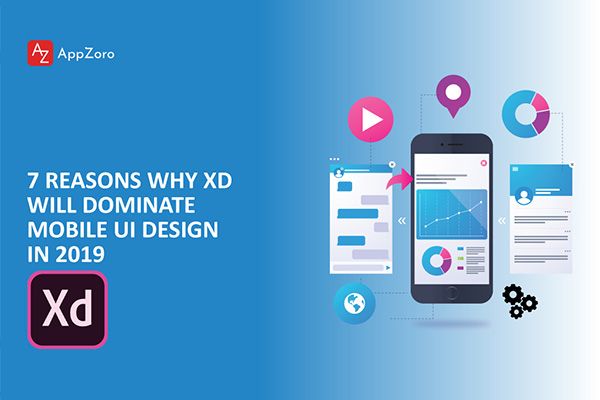Adobe’s answer to Sketch is Adobe Experience Design (XD). For many years sketch has been the pioneer tool for ui/ux design and development services, and has created a community that includes a set of plugins, forums, and integration with tools like Figma and InVision. The only issue Sketch has that it’s exclusive to Mac users. Windows users still used to create UI/UX sets on tools like Adobe Photoshop.
If you are an old existing Sketch user and are not interested in what XD has to offer, do yourself a favor and keep reading the below post. Adobe itself has claimed in the Adobe Max Conference 2018 that XD is going to be bigger than Photoshop. To be noted that, Photoshop is the largest platform for designers to create artworks globally. There is just no alternative.
The history of User Inter Interface Tools
Since the inception of mobile applications and design the go-to tool for all designers was Photoshop. However, Photoshop was never created for User interaction and Experiences in the first place. It is a tool focused on photo editing, creating illustrations and was later picked up by interaction designers due to no other alternatives.
Photoshop does the work, but there are many barriers if you’re looking for collaboration, prototyping, and testing. Its native files in the PSD format are heavy and leaves no room for designers to seamlessly collaborate and manage files.
Post iMac era, Sketch came into the picture and addressed some of the most significant issues related to interaction designing and evolved the market by grabbing a considerable share from other interaction designing tools. Sketch allows reusable symbols, faster workflow, and cloud management of your designs. The sketch became mainstream after it allowed third-party applications like InVision, multiple fonts on the cloud, and iPhone connectivity to test applications, making it the market leader in the interaction design tools category.
Cloud applications like InVision also gained the market share due to their nature of collaboration on the cloud and allowing feedback from all of the stakeholders. While all this was happening, Adobe still had Photoshop and Illustrator as the primary tool for interaction designers but didn’t make any more sense to switch it from a powerful tool like Sketch. Windows users were still stuck on basic applications like Balsamiq, Marvel, InVision, and even paper prototyping.
Adobe launched XD in 2016 in beta mode and resembled Sketch’s multi artboard designing tool skin. It was smooth, less clunky than Photoshop, and had all of the features to pull out User Interface like a charm. After a successful beta, Adobe did something, which will stimulate them to grab the market share of Sketch and become one of the most significant tools for Designers.
“In 2018, Adobe made XD completely free to use. “
Yes, you read it right. An interaction tool as capable as market leader Sketch, completely free and integrated with Creative Cloud. The market responded actively and loved what Adobe did. Let’s check some of the features that make Adobe XD the go-to tool for interaction designers—and why many professionals at a web apps development company rely on it to create beautiful web and mobile applications..
1. Voice triggers
Taking inspiration from Alexa and Google home, Adobe XD has allowed users to interact with their creations and prototypes with voice triggers and speech playback. It has enabled users to give a presentation of a touchless interface. No other interaction design software supports voice.
For example, now when you create the registration form on Adobe XD, you can put a command like “Allow Me” to bypass the registration without clicking anything. So whenever you are presenting a prototype in a presentation or a meeting, just say the keywords “Allow Me,” and it will directly take you to the next screen.
2. Auto Responsiveness
This is going to be the most prominent feature and will re-think designers from using other interactive applications like Sketch. Several man-hours are spent to create desktop and mobile versions of the same interface. Adobe has solved this problem phenomenally. The auto responsiveness allows you to simply pull or squeeze your artboard according to the screen size, and create every element as responsive. As a designer, you will save multiple hours to create a variance for other screen sizes. Now you just have to create a single set of designs either in desktop and mobile mode and squeeze accordingly or let Adobe do the magic.
3. Auto animate
Adobe has integrated it’s AI Sensei in XD. It understands the various screens and suggests you apply animation over them. Animations like a shrink, stretch in, stretch out, fade-in, and can be performed manually Auto-Animate feature will auto-suggest animation and give you a surprise.
4. Connected symbols
XD has evolved the symbol ecosystem by integrating and linking all of the characters and frequently used symbols together. Now when you change one element anywhere in the artboard, you have the option to confirm those changes across your artwork. For example, while creating a website, if you want to change the logo across all artboards, you will just have to change it on one screen, and it will auto-reflect on and all of the screens.
5. Seamless Adobe Connectivity
Are you using Photoshop or Illustrator to create illustrations and designs and then import them into XD. Earlier you have to save a file and then import it. Now Adobe directly allows you to copy and paste various designs across all its applications like Adobe After Effects, Illustrator, and Photoshop to XD.
Adobe also allows you to open Sketch files in XD. Adobe is undoubtedly looking to compete with Sketch in its own game by providing existing designers a reason to Adobe XD.
6. Link Sharing
Adobe allows you to share your entire creation via a single link on which multiple stakeholders can collaborate and provide comments and suggestions. You can update this link by re-saving your design, and all of the stakeholders will be notified. There is no reason left to export your artboard into PNG’s, import it into inVision (The free version only allows 8 screens) and then show it to the team/client. Adobe does all of it with a single click.
7. Developer Friendly
Adobe allows you to create developer-friendly links to show your entire artwork and breakdown element-wise. This helps the front-end developer to easily navigate and review color schemes as it provides hex code information, font names, padding, and margin details.
Way Forward
Adobe apparently aims to become the one-stop solution for prototyping design and animation. It is also integrating testing and collaboration together, which makes the entire workflow faster and seamless. By making workflows simpler, it’s addressing one of the most significant problems for designers. Adobe is holistically solving it by its native cloud app Creative Cloud.
This scenario is also a red flag for other competitors like InVision and sketch, as it becomes hard to compete with the overall Adobe ecosystem. So get on your hands on the new Adobe XD, as it’s the future of interaction design, and it’s also free.
Are you looking for a Mobile Application to be designed in Adobe XD, Appzoro provides a beautiful User Interface for Mobile applications across Android & iOS. Kindly drop a mail on info@appzoro.com or visit at www.appzoro.com.
Also Read: [**How to Track Project Performance?**](https://appzoro.com/blog/how-to-track-project-performance)

Leave a Comment